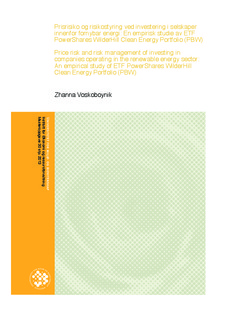| dc.contributor.author | Voskoboynik, Zhanna | |
| dc.date.accessioned | 2013-08-28T09:43:33Z | |
| dc.date.available | 2013-08-28T09:43:33Z | |
| dc.date.copyright | 2013 | |
| dc.date.issued | 2013-08-28 | |
| dc.identifier.uri | http://hdl.handle.net/11250/187486 | |
| dc.description.abstract | In this master thesis we analyze the price risk of investing in companies operating in the renewable energy market and implications of our findings for risk management. Daily-adjusted close prices of ETF PowerShares WilderHill Clean Energy Portfolio (PBW) from the third of March 2005 to the 31st of January 2012 are used in analysis. Excel is used as analytical tool.
We find that the prices of PBW are highly volatile with the annual standard deviation of 45,60% for the whole observation period. We discover that 67% of the price variation can be explained by systematic risk measured with beta. PBWs beta is 1,39 for the whole period, but it is unstable over time. We analyze the risk in the distribution`s tails with parametric and non-parametric Value-at-Risk and Expected Shortfall. When parametric VaR appears not to pass the back-test we conduct graphical and statistical analysis of PBW`s distribution. We discover that the distribution is not normal with negative skewness and fat-tails.
We test the hypothesis of stochastic volatility and study price jumps as a possible explanation for observed distribution. Rolling volatility and the stochastic volatility models GARCH and EWMA confirm that PBW´s volatility is stochastic. Study of price jumps detects jumps.
The last part of the thesis is devoted to the implications of our findings for risk management. We discuss the possibility of using volatility adjusted GARCH-VaR as an alternative risk measurement. We show that stop-order strategy will be insufficient when prices tend to jump. Further, the discussion is focused on use of options in risk management. We discover that 100% options insured long and short positions in PBW will be less affected by price jumps than positions without options. We show that jump-risk is not symmetric for long and short options. Risk is much higher for out-of-the-money short options. We discuss the delta-hedging risk management strategy for short options. Our analysis show that delta-hedging can reduce jump-risk, but this type of risk can´t be removed completely with delta-hedging. | no_NO |
| dc.language.iso | nob | no_NO |
| dc.publisher | Norwegian University of Life Sciences, Ås | |
| dc.subject | Prisrisiko | no_NO |
| dc.subject | risikostyring | no_NO |
| dc.subject | systematisk risiko | no_NO |
| dc.subject | fete haler | no_NO |
| dc.subject | VaR | no_NO |
| dc.subject | GARCH | no_NO |
| dc.subject | EWMA | no_NO |
| dc.subject | hopp-risiko | no_NO |
| dc.subject | opsjoner | no_NO |
| dc.subject | stop-order | no_NO |
| dc.subject | delta-hedge | no_NO |
| dc.title | Prisrisiko og risikostyring ved investering i selskaper innenfor fornybar energi : en empirisk studie av ETF PowerShares WilderHill Clean Energy Portfolio (PBW) | no_NO |
| dc.title.alternative | Price risk and risk management of investing in companies operating in the renewable energy sector : an empirical study of ETF PowerShares WilderHill Clean Energy Portfolio (PBW) | no_NO |
| dc.type | Master thesis | no_NO |
| dc.subject.nsi | VDP::Social science: 200::Economics: 210::Economics: 212 | no_NO |
| dc.source.pagenumber | 83 | no_NO |
